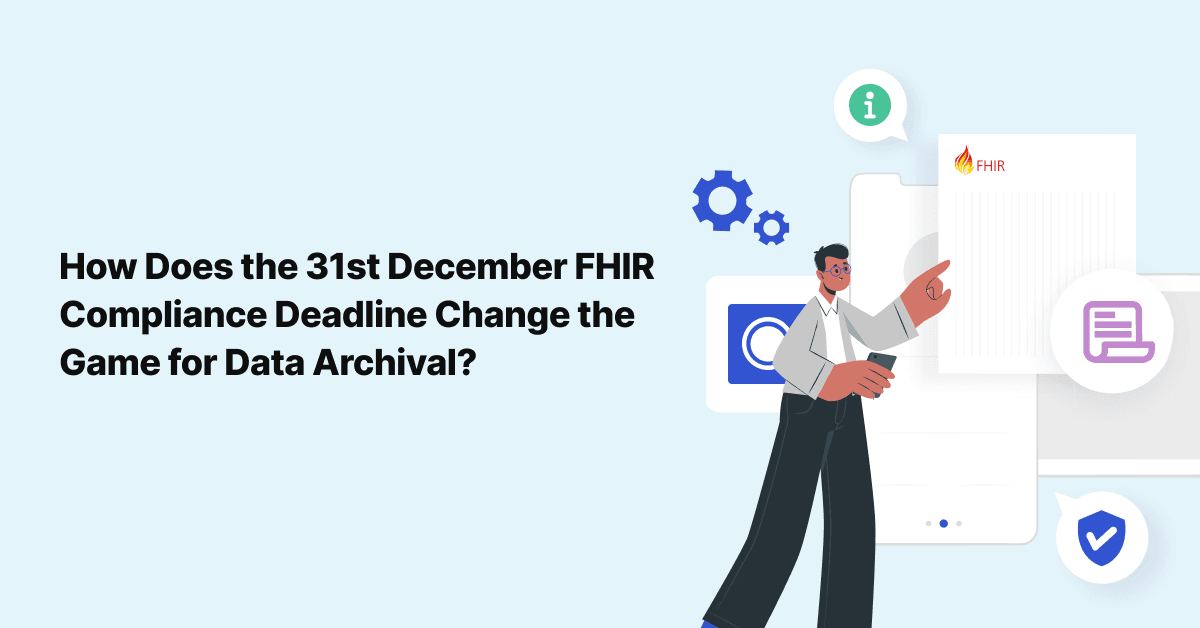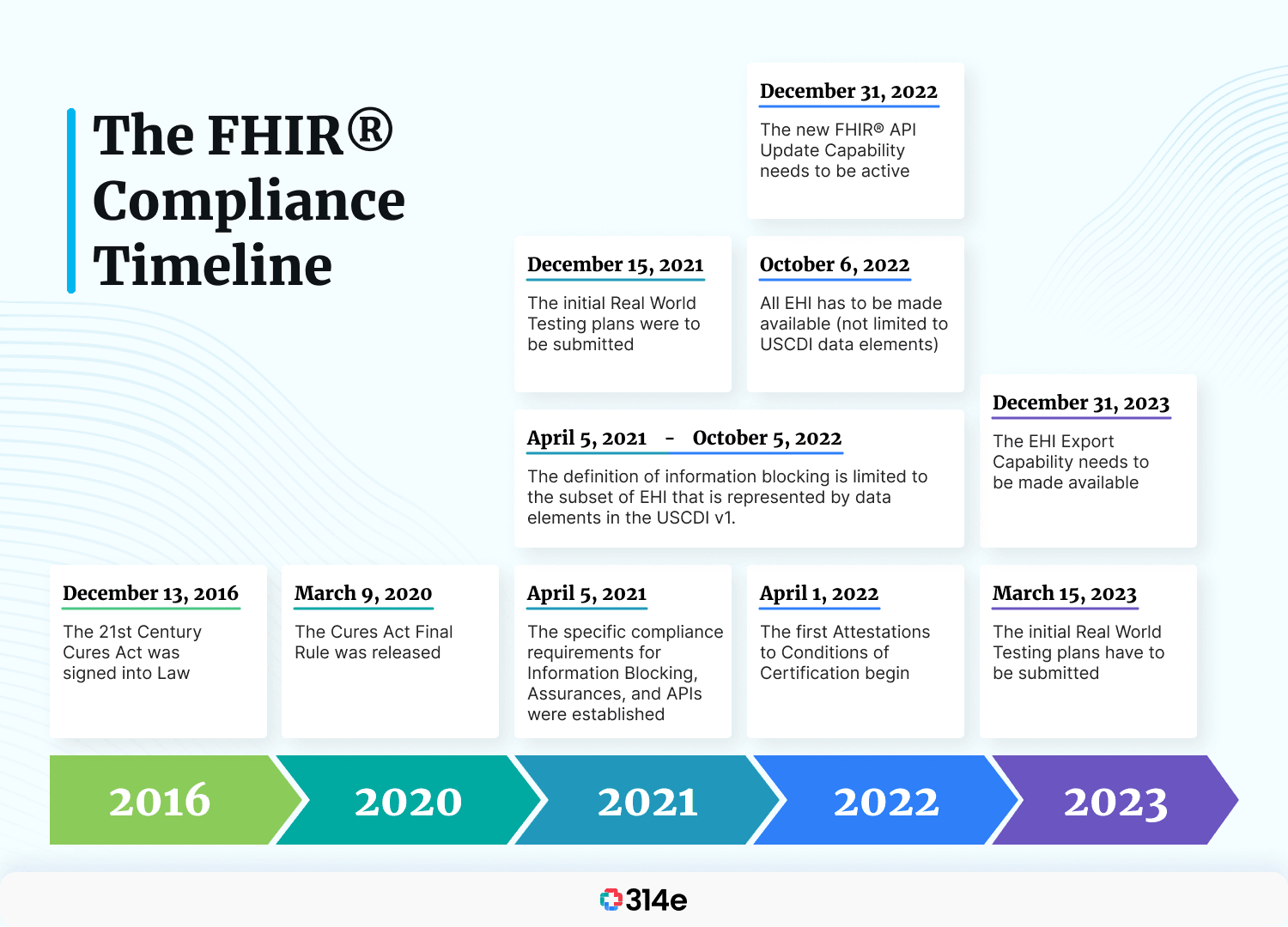

How Will the FHIR Mandate Impact Your Data Archival Strategy?
16 November, 2022 | 5 Min Read | By Amrit PalariaThe ONC’s Cures Act, which is otherwise referred to as the 21st Century Cures Act, was enacted and signed into law in 2016. The Act’s primary purpose was to accelerate the development of drugs and medical devices. Apart from this, the Cures Act also aims to bring down the regulatory burden connected with EHRs and other Health Information Technology (HIT). The Act also offers a standardized format called the Fast Healthcare Interoperability Resources (FHIR®) that enables the interoperability of health information like clinical and administrative data between different health systems.
In this article, you will learn about:
The Importance of FHIR®
FHIR® endpoints refer to Health Level Seven (HL7®) organization standards that facilitate the secure exchange of clinical and administrative data between healthcare providers, Health Information Exchanges, Health IT vendors, and payers. FHIR® APIs enable smooth access and data sharing between medical facilities. FHIR® endpoint is the particular connection point to where the data is stored. The patient data is accessible at the FHIR® endpoint.
FHIR® APIs, amidst all other APIs, improve interoperability and pave the way for enhanced healthcare. FHIR® exists not just with the goal of enhancing interoperability but also encouraging safer transitions of care and improved privacy of patient health information. The FHIR® API is also important to your health system for the following reasons:
- It avoids any kinds of problems in data exchange and attempts to set up an open ecosystem for interoperability
- It also eliminates all kinds of complexities and ensures a simplified implementation and adoption through its consistency
- It enables easy and quick third-party integration; FHIR® is application-oriented and can smoothly adapt to any software by keeping the base requirements the same and adapting to the local requirements
- It benefits the providers and payers by enabling necessary health information transfer and by making the data manageable
- It also keeps patients informed by allowing them to keep track of their medical records
The FHIR® Compliance Timeline
The following timeline would help you better understand the FHIR® deadlines that are required to be met and would also help you get a bigger picture of interoperability between health systems.

The Requirements to Be Met
The new secure API adopted by the ONC has made it a mandate for developers of standard health IT to meet the following technical requirements:
- Base standard
The FHIR® release standard 4.0.1. must be supported by API technology.
- Application registration
API technology must be able to register software applications with authorization software before permitting them to interact with API technology.
- Technical documentation
The publicly accessible hyperlinks must be used for the design and registration of software applications interacting with API technology.
- Security
Transport Layer Security (TLS) version of 1.2 or higher versions must be used by API for the purpose of establishing a secure connection with software applications for all transmissions. API technology must perform additional authentication on software applications that are to be used for clinical purposes.
- Authentication and authorization
API technology must demonstrate its authorization and authentication as per the SMART App Launch Implementation Guide for every patient request to access data.
- Patient authorization revocation
API technology’s authorization server must be capable of revoking an authorized app’s access to patient data when it is directed by the patient.
- Data access and search
API technology must respond to requests for data specified in the USCDI v1 according to the US FHIR® Core Implementation Guide (US FHIR® Core IG) for FHIR® Release 4.
The new mandate would help patients stay protected and ensure the privacy of patient data without causing implications to the information blocking rule. As far as providers and health IT developers are concerned, it would help reduce API development and maintenance costs and improve patient safety. If you are a provider or payer, here is a guide for you to comply with the 21st Century Cures Act.
The Impact on Data Archival
The importance of FHIR® for health data archival strategy is unmatched as it ensures simplified implementation without compromising the integrity of patient health information. One of the primary impacts that the new FHIR® mandate and the Cures compliance mandate would bring about is that it would improve the interoperability in the sense that the data archived in FHIR® format can easily be exchangeable as FHIR® resources with other parties with little or no modifications required before the exchange. It also impacts data archival and improves interoperability in the following ways:
- The archival requirements permit health IT developers to publish an endpoint in any format. This can slow down data sharing by making it a cumbersome process. The new mandate requires to be published endpoints to be standardized, thereby making it a streamlined process. The data standardization would also lead to reduced administrative costs.
- The FHIR® mandate would bring down the burden of the authorization documentation by bringing about transparency in the documentation and providing clarity to the providers about the requirements.
- This would bring about transparency in the process of denials and also improve the Prior Authorization (PA) turnaround time.
- The FHIR® API has the ability to improve the patient experience by understanding the health tier they are on and providing them with just the relevant information.
By complying with the new FHIR® mandates, health systems would possess the capability to align legacy data with the requirements of the 21st Century Cures Act and provide it with a consumable format to enhance patient care. At 314e, we have our very own FHIR® native data archival tool - Muspell Archive, that has intelligence built in to solve all the data archival problems. Muspell Archive ensures security in data archival by being FHIR compliant.
If you are on the lookout for an FHIR-compliant data archival vendor that improves the provision of patient care through improved interoperability, get in touch with us!
Stay on Top of Everything in Healthcare IT
Join over 3,200 subscribers and keep up-to-date with the latest innovations & best practices in Healthcare IT.
Related posts


Choosing Your Ideal Healthcare Data Archival Solution
Since the release of the Cures Act Final Rule in May 2020, the US healthcare industry has been experiencing a …

Exploring Muspell Archive’s Dual Data Security Layers
Legacy patient health data holds a wealth of information, including crucial historical insights, essential for …